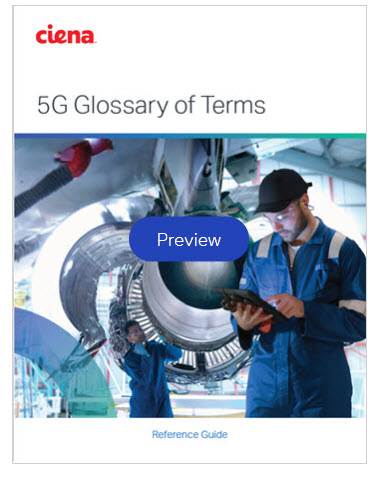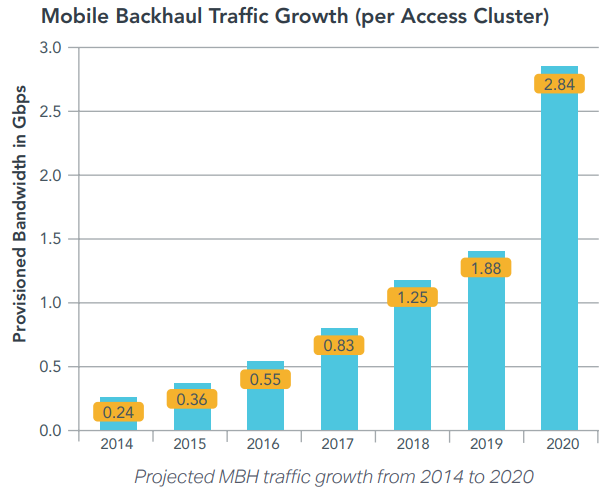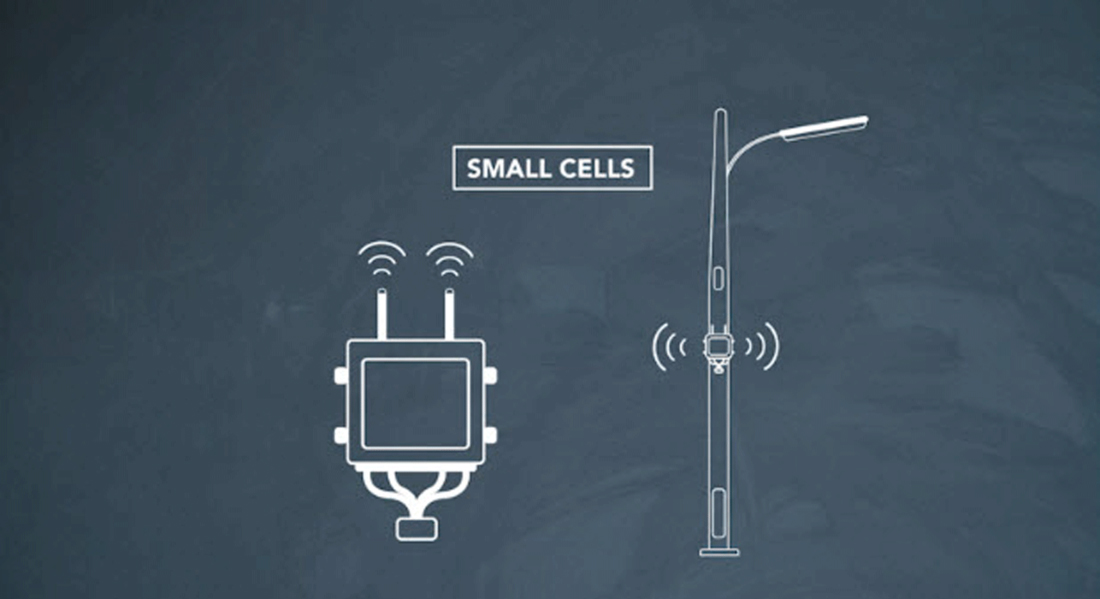5G wireless needs fiber, and lots of it
According to the International Telecommunications Union's (ITU) latest “Trends in Telecommunication Reform” report, ongoing capital investments related to fiber infrastructure are expected to total a staggering $144.2B between 2014 and 2019. One of the primary drivers for this immense capital investment into fiber infrastructure deployments comes out of thin air, in the form of tomorrow’s 5G radios.
5G mobile networks will significantly affect both the wireless side (obviously!) and the wireline side of the global network infrastructure, as airborne bits jump to and from terrestrial wireline networks. In a previous post, I summarized the main aspirational performance goals of 5G, which are listed below. These formidable network performance goals are heavily predicated on the availability of fiber, and lots of it, to the cell sites.
- Up to 1000 times increased in bandwidth, per unit area
- Up to 100 times more connected devices
- Up to 10Gbps connection rates to mobile devices in the field
- A perceived network availability of 99.999%
- A perceived 100% network coverage
- Maximum of 1ms end-to-end round trip delay (latency)
- Up to 90% reduction in network energy utilization
Traditionally, 2G and 3G mobile networks often used copper-based Time Division multiplexing (TDM) circuits, such as multiple bonded T1s or E1s, to connect cell sites to a nearby Mobile Switching Center over the Mobile Backhaul (MBH) network. Although this now legacy MBH architecture has indeed served the industry well for decades, it’s quickly showing its age with advent of 4G. MBH upgrades are taking place all over the world converting legacy copper-based MBH serving cell sites to packet-based transport over fiber, which enables far higher capacities to best future-proof MBH networks. The increased adoption of 4G LTE and LTE-Advanced mobile network technology is accelerating these MBH fiber upgrades, which can and will be leveraged by future 5G networks, given the almost unlimited bandwidth that fiber-based networks offer.
 To improve the coverage, capacity, and overall Quality of Experience (QoE) of mobile users, Mobile Network Operators (MNOs) are adopting small cells, which strategically place radios closer to users. Small cells can be backhauled over copper (xDSL, HFC-based cable modems…), air (microwave, millimeterwave…), or fiber (Ethernet, PON…). All three media options are being used today, to varying degrees, with the technology choice based on economic, environmental, regulatory, and time-to-market criteria, which are often specific to the target geographic location and application. Fiber-based small cell MBH is always the preferred option, whenever and wherever possible, because the technology is scalable, secure, understood, and in many cases, the most cost-effective. However, there are indeed cases where deploying fiber simply isn’t a viable option.
To improve the coverage, capacity, and overall Quality of Experience (QoE) of mobile users, Mobile Network Operators (MNOs) are adopting small cells, which strategically place radios closer to users. Small cells can be backhauled over copper (xDSL, HFC-based cable modems…), air (microwave, millimeterwave…), or fiber (Ethernet, PON…). All three media options are being used today, to varying degrees, with the technology choice based on economic, environmental, regulatory, and time-to-market criteria, which are often specific to the target geographic location and application. Fiber-based small cell MBH is always the preferred option, whenever and wherever possible, because the technology is scalable, secure, understood, and in many cases, the most cost-effective. However, there are indeed cases where deploying fiber simply isn’t a viable option.
The maximum theoretical download speed for LTE-Advanced (Release 8) is 300Mbps, although typical real-world download speeds are far lower at about 40Mbps, if you’re fortunate enough to even have this type of service coverage in your neck of the woods. As an increasing number of mobile users access more video-centric content for longer periods of time using increasing powerful smartphones, Radio Access Network (RAN) bandwidth demands will continue to grow, unabated.
The Math: 4G vs 5G Speeds
Today, a typical modern macrocell is served by a 1GbE packet-based optical MBH network link, although the typical traffic over this 1GbE physical connection is about 200Mbps to 300Mbps, leaving some room for growth, for 4G networks. Thus, the total aggregate bandwidth consumed by all of the concurrent mobile users to a typical macrocell is roughly equivalent to the maximum theoretical download speed of a single LTE-Advanced (Release 8) user connection. Granted, this is a rough estimate but you see where I’m going. Although current MBH networks may suffice for 4G today, the promised access speeds of 5G is likely going to overload existing MBH networks quite quickly.

MNOs connecting 3G and 4G cells, small and macro, via fiber are also laying the foundation for 5G, which has maximum theoretical download speeds from 1Gbps for high mobility users (ex. bullet train commuters) to 10Gbps for low mobility users (ex. stationary, walking). Even if the maximum theoretical download speed of 10Gbps were scaled down by 90% to 1Gbps, the entire 1GbE MBH connection to a typical macrocell today, intended to serve all concurrent 4G users, would be consumed by one bandwidth-hungry 5G user, like me.
The access network, which includes the RAN, is the one part of the global network infrastructure that still has a significant amount of copper and wireless technology deployed, which will be a problem for 5G deployments, due to the promised speeds of this new technology. - Brian Lavallée, Director of Portfolio Solutions Marketing
It’s important to lay fiber now to small and macro cells, wherever and whenever possible, if these cell sites are to be upgraded to 5G in the coming years, as copper and air-based MBH options simply cannot scale to the immense amount of backhaul traffic that’ll be generated by a 5G RAN. Fortunately, 5G is intended as an overlay to existing 3G/4G mobile networks, meaning that for existing cells that need not be upgraded to 5G in the future, using air and copper-based backhaul options are viable options for today, and tomorrow.
Most bandwidth consumed over mobile network airwaves is related to video-centric content flowing from a distant data center located across a city, a country, or even an ocean. Our growing affinity, dependence, and downright addiction to our mobile devices has led them to being the often preferred access vehicle to online content relegating cable and xDSL modems to a more secondary role. If 5G is to be aggressively rolled out in the coming years delivering real-world access speeds significantly faster to what’s available on today’s 3G/4G networks, whatever the 5G speed will ultimately be, all parts of the wired network connected to the RAN will be affected by the deluge of content flowing to and from data centers. The only transport media capable of scaling to these demands is fiber meaning it’ll have to be available everywhere, particularly in the RAN to the hundreds of thousands of small and macro cells deployed worldwide.
5G for Fixed Broadband
Another monkey wrench in the works is using fixed 5G access as a broadband replacement technology, which some carriers are considering. Although the “mobile” part is removed once the 5G radios are installed in a residential or business premise, they’ll still have a major effect on the RAN, and every part of the network between cell sites and data centers. Deployments of fixed 5G broadband access should be quicker and easier to deploy than running cables to premises meaning the rate that bandwidth can be turned up is accelerated, which will exacerbate bandwidth pressures on all parts of the global network. Although 5G fixed access will result in less fiber required to the premise, more bandwidth is turned up faster, meaning more RAN fiber.
Essentially all metro, regional, long haul, and submarine networks today are fiber-based, meaning they can already scale to voracious DCI growth by leveraging the very latest in optical transmission technologies. The access network, which includes the RAN, is the one part of the global network infrastructure that still has a significant amount of copper and wireless (microwave/millimeterwave) technology deployed, which will be a problem for 5G deployments, due to the promised speeds of this new technology. Areas targeted for 5G coverage require lots of fiber to be successful, and not just for capacity reasons, but also to meet the other rather formidable 5G performance goals related to network diversity, availability, and coverage, since all three of these goals are achieved through a greater number of interconnected paths, of fiber. It’s rather ironic that the projected performance goals of 5G wireless will depend on the availability of wireline fiber.
In fact, the only reason we don’t have fiber connected right to our smartphones is because we’d be less mobile.











